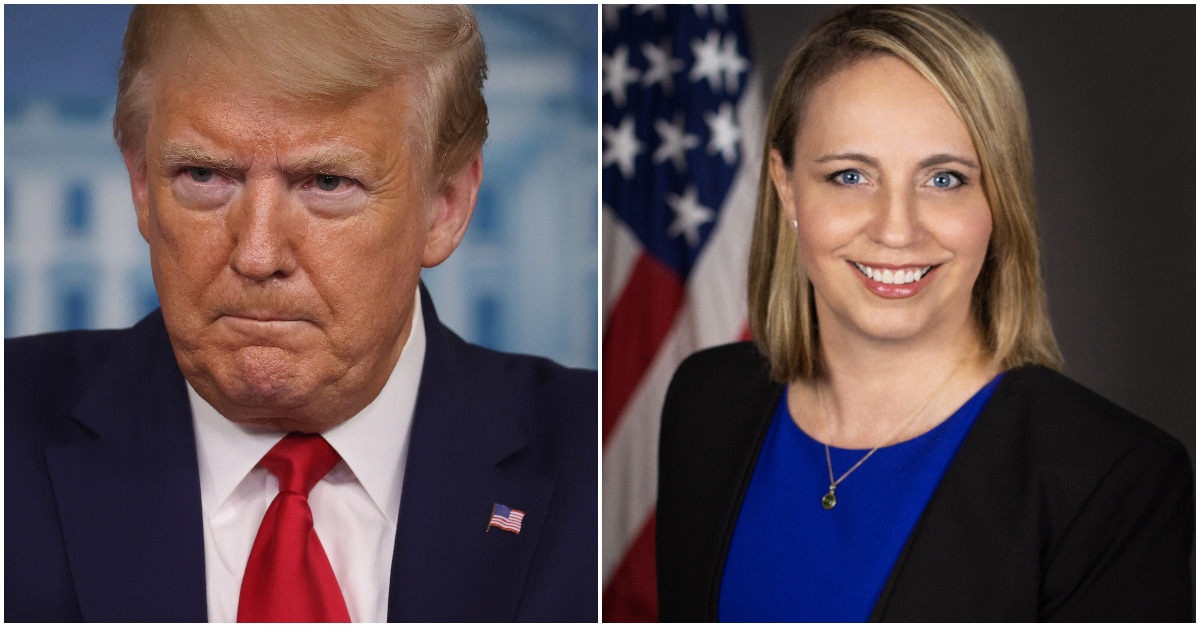
The Department of Health and Human Services Office of Inspector General (OIG) is fighting back against President Donald Trump‘s Tuesday criticism of a Monday report on the extreme challenges hospitals are facing during the COVID-19 pandemic. Trump called the report “Another Fake Dossier,” an apparent allusion to the discredited opposition research compiled by Christopher Steele for Trump’s political opponents in 2016.
“Why didn’t the I.G., who spent 8 years with the Obama Administration (Did she Report on the failed H1N1 Swine Flu debacle where 17,000 people died?), want to talk to the Admirals, Generals, V.P. & others in charge, before doing her report,” Trump tweeted late Tuesday morning. “Another Fake Dossier!”
Why didn’t the I.G., who spent 8 years with the Obama Administration (Did she Report on the failed H1N1 Swine Flu debacle where 17,000 people died?), want to talk to the Admirals, Generals, V.P. & others in charge, before doing her report. Another Fake Dossier!
— Donald J. Trump (@realDonaldTrump) April 7, 2020
Notably, Trump’s characterization of HHS OIG Christi Grimm as something of an Obama-era plant does not ring true. According to her federal biography, Grimm is a career OIG official who began working with the agency as a program evaluator in 1999–during the Bill Clinton presidency. She’s been there through Clinton, Bush, Obama, and Trump–Democrats and Republicans. She was elevated to her recent position by the Trump Administration in January of this year. In other words, Trump just trashed his own OIG.
Grimm’s report is titled “Hospital Experiences Responding to the COVID-19 Pandemic.” The subtitle of that Monday report notes that the information contained therein is based on “Results of a National Pulse Survey March 23-27, 2020.”
A pulse survey is a brief survey submitted to employees who work at a specific organization in order to gain insight and sentiment in a relatively quick and easy fashion compared to more long-form survey methods. They typically contain a small number of highly-focused questions and are also useful for understanding trends over time.
Grimm explained her agency’s methodology:
[The] report is based on brief telephone interviews (“pulse surveys”) conducted March 23-27, 2020, with hospital administrators from 323 hospitals across 46 States, the District of Columbia, and Puerto Rico, that were part of our random sample. Our rate of contact was 85 percent.
Interviews focused on three key questions:
1.What are your most difficult challenges in responding to COVID-19?
2.What strategies is your hospital using to address or mitigate these challenges?
3. How could government best support hospitals responding to COVID-19?
As Law&Crime previously reported, the results of the HHS OIG report largely tracked with daily official press briefings and media reporting on the novel Coronavirus (COVID-19) pandemic–and the results are focused directly on the strain and toll that hospitals are currently experiencing.
“Hospitals said that severe shortages of testing supplies and extended waits for test results limited hospitals’ ability to monitor the health of patients and staff,” the report notes. “They also reported that widespread shortages of personal protective equipment (PPE) put staff and patients at risk.”
Trump’s Tuesday morning complaint about Grimm failing to contact various military brass and Vice President Mike Pence is inapposite to the scale and purpose of the report’s undertaking. The point of the report was to present a ground-up review of the current situation for leaders to examine. As the HHS OIG summary explains:
[The] review provides the Department of Health and Human Services (HHS) and other decision-makers (e.g., State and local officials and other Federal agencies) with a national snapshot of hospitals’ challenges and needs in responding to the coronavirus 2019 (COVID-19) pandemic. This is not a review of HHS response to the COVID-19 pandemic. We have collected this information as an aid for HHS as it continues to lead efforts to address the public health emergency and support hospitals and other first responders. In addition, hospitals may find the information about each other’s strategies useful in their efforts to mitigate the challenges they are facing.
The report broadly grouped the responses from hospitals as requests for assistance in five categories: “1) assistance with testing, supplies, and equipment (e.g., PPE); 2) assistance with workforce allocation; 3) assistance with capacity of facilities; 4) financial assistance; and 5) communication and public information.”
The HHS Office of Inspector General on Tuesday responded to Trump’s criticism of the report in a message to Law&Crime:
We approached this survey with the same integrity and quality standards as we have in previous work. We interviewed knowledgeable professionals at more than 320 hospitals across 46 states, the District of Columbia, and Puerto Rico. Let me be clear, the survey is not a review of HHS’ response to the COVID-19 pandemic. Instead, we collected this information as an aid for HHS and other decision-makers as they continue to lead efforts to address the public health emergency and support hospitals and other first responders. We recognize that HHS, Congress, and other government entities across the Federal, State, local, and Tribal levels are taking substantial actions on a continual basis to support hospitals in responding to COVID-19. HHS has already taken and continues to take actions related to each of the challenges that hospitals identified in our survey, and the Coronavirus Aid, Relief, and Economic Security (CARES) Act provides the basis for additional actions.
Read Grimm’s full report below:
Hospital Experiences Responding to the COVID-19 Pandemic by Law&Crime on Scribd